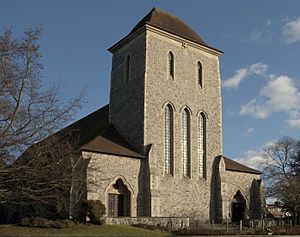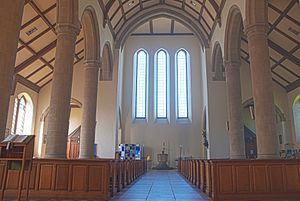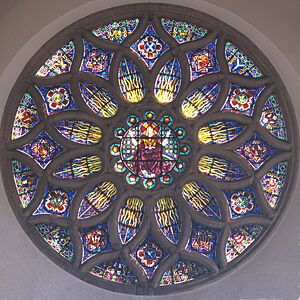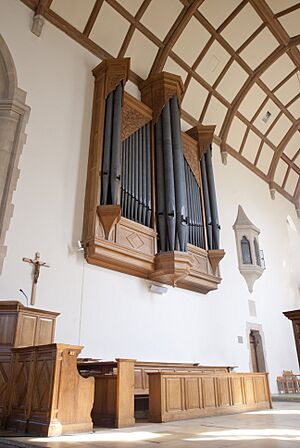All Saints' Church, Hockerill facts for kids
Quick facts for kids The Parish Church of All Saints', Hockerill |
|
|---|---|
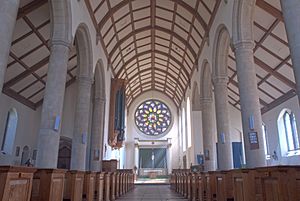
All Saints' Hockerill looking east
|
|
| Location | Bishop's Stortford, Hertfordshire |
| Country | England |
| Denomination | Church of England |
| Website | allsaintshockerill.org.uk |
| History | |
| Consecrated | 7 January 1852 (burnt down) 24 July 1937 |
| Architecture | |
| Heritage designation | Grade II (UK) |
| Architect(s) | George Pritchett (1851) Stephen Dykes Bower (1936) |
| Architectural type | 20th-century Gothic Revival |
| Administration | |
| Parish | Hockerill |
| Diocese | St Albans |
All Saints' Church, Hockerill is a special building in Bishop's Stortford, England. It is listed as a Grade II historic building, which means it is important and protected. This church is famous because it was the first church designed by a well-known architect named Stephen Dykes Bower. It also has a beautiful round window called a rose window, made by Hugh Ray Easton. Inside, there is a large pipe organ built by Henry Willis II.
Contents
Church History
For many years, Bishop's Stortford had only one church parish. As more people moved to the area, the church became too crowded. So, the vicar of St Michael's Church, Francis William Rhodes, decided to divide the area into three new parishes.
Building the First Church
The first All Saints' Church in Hockerill was built in 1851. It was designed by a local architect, George Pritchett. The church officially opened on January 7, 1852. This church was a "Commissioners' church," meaning the government helped pay for it. Queen Victoria created the new parish for this church on February 2, 1852. John Menet became the first vicar of the parish. He was also the first chaplain for a nearby college that trained schoolmistresses.
The Fire of 1935
On June 21, 1935, a big fire badly damaged the church. This event was reported in national news. People from the village tried to put out the fire, but it quickly spread to the roof. The vicar, Reginald J. Mockridge, and other villagers managed to save important items. They rescued things like the Communion plate, church records, and a special stand for reading (lectern). The roof fell in less than an hour. Firefighters had trouble because there was not enough water.
Rebuilding the Church
People started collecting money for a new church on the very day of the fire. The new church cost about £27,178 in total. About £9,528 of this money was raised by the public. Many people helped, including royalty. Queen Mary of Teck donated a pair of vases for an auction. The Duchess of York, who later became Queen Elizabeth The Queen Mother, gave a special blotter and a picture of Princess Elizabeth (who later became Elizabeth II). Even movie stars sent signed photos to help raise money. The first stone for the new church was laid on July 20, 1936. The new church was officially opened on July 24, 1937.
Church Design
The church built in 1936 was the first church designed by Stephen Dykes Bower. He spent his whole career working on churches in the Gothic Revival style. This style brings back the look of old Gothic cathedrals. Many people think All Saints' is one of his best churches. It mixes traditional design with new ideas, making it unique.
Outside the Church
The west side of the church is very noticeable in Bishop's Stortford. It has a tall, wide central tower with a steep, distinctive roof. There are also three very tall, narrow windows called lancets. The church is built with strong stone, which makes it look very grand. Large supports called buttresses stand on the sides of the church. At the southwest entrance, there is a wooden gate from the 1800s. This gate is the only part of the first church that was not damaged by the fire. Dykes Bower used parts of the old church when he designed the new one.
Inside the Church
The inside of the church has a simple layout. There is a main area called the nave and two side areas called aisles. These lead to a long chancel, which is the area near the altar. At the base of the tower, there is a special entrance area called a narthex. This area holds the baptistery, which is directly in line with the main altar. The inside of the church feels bright and open. This is because of the large open spaces, many tall windows, and light-colored walls. The nave is very tall, about 45 feet (14 meters) high. Huge round pillars and pointed arches hold up a special ceiling. The open feel and ceiling design are also seen in other churches designed by Dykes Bower.
Rose Window
The most eye-catching part of the church's interior is a large rose window. It is 18 feet (5.5 meters) wide and is located at the east end, above the main altar. This window was designed by Hugh Ray Easton. It is the main source of color in the building. The window has many detailed geometric shapes and rich, deep colors. These colors stand out against the plain walls and stone of the church. In the center of the window, there is a picture of Christ in Majesty. Around him are symbols of the Gospel writers and apostles. The design is similar to another rose window Dykes Bower worked on at Lancing College Chapel.
Willis Organ
The church has a two-manual organ built in 1937. It was made by Henry Willis II of Henry Willis & Sons. The organ pipes are placed high up on the north wall of the chancel. This position helps the sound fill the church beautifully. Dykes Bower designed the organ's case. You can see some of the large pipes on display. More details about the organ can be found on the church's official website.
All Saints' Today
All Saints' Church follows the Affirming Catholicism tradition within the Church of England. It also welcomes people from other church traditions. There are eight different church services held regularly. The church has many activities for young people, including a children's Sunday school and a youth group. There is also a film club and a Mother's Union. People can join small groups at home or help as pastoral visitors, altar servers, or flower arrangers. A robed choir sings every Sunday, and a children's choir sings at the All-Age Mass. The church is a popular place for concerts because of its excellent sound quality. All Saints' Church is also connected to All Saints' Church of England Primary School and Nursery. The church building is usually open during the day, from 9 AM to 6 PM.


